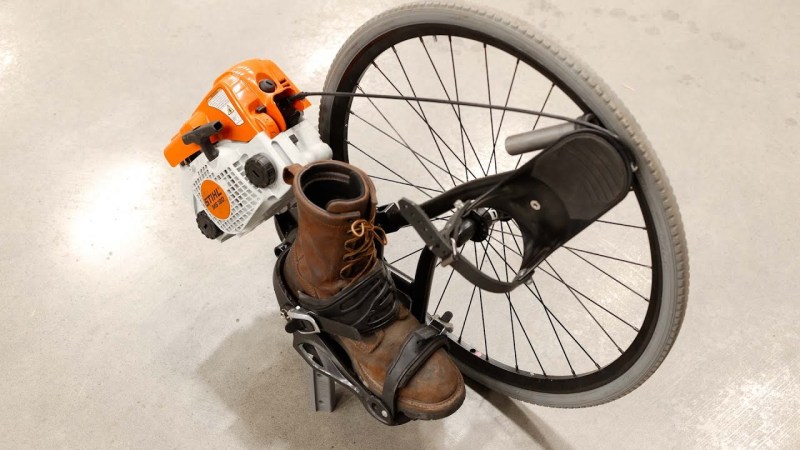Roller skates are fun and all, but they’re pretty well limited to rolling on relatively smooth surfaces. [Fireball Tool] wanted something a little more rugged, so set about a build of his own.
The challenge of the design was to build these skates using as many wheelchair parts as possible, including the wheels. Roughly 22″ tall, the wheels have great bearings inside and are designed to run on a single-sided axle support, perfect for the skates. A metal bracket is then used to attach a snowboard boot binding so the wheels can be fitted to the wearer’s feet. Training wheels were fitted to the rear to make it easier for the rider, while a chainsaw engine was pressed into service to provide some welcome propulsive force.
In a short test on a flat workshop floor, the wheels performed ably. The hope is that the large diameter wheels should do better than traditional roller skates would on rough surfaces like grass or dirt. We look forward to seeing that test in action as a comparison to other powered skates we’ve seen. Video after the break.
















That’s gonna hurt!
Be prepared for a ripped ligament or outright twisted leg at the knee, or worse. The amount of force even if you strap below the knee than can be applied to that point given the size of the wheels and weight with “better traction plus the motor is likely a bad idea. The old movie shows much smaller wheels. I would suggest a smaller diameter with maybe a balloon tire that can handle rocks. It bears mentioning that there is a difference between “quad-skates” and inlines in that the center of gravity is different, with the tendency to either fall back-to-front/reverse on quads, and side to side on inlines, the length and position of the boot of course matters. You have created something in between with the training wheel and the position for center of gravity.
What you need to be careful is that angular momentum is not translated though the edge of the wheel at the knee level, or directly at the angle at the center hub. I’m not sure on that model he made how that energy is translated or where – but his knee is directly positioned at the outside of the wheel diameter and having training wheel likely won’t fix that. Having an engine on it also adds weight to the momentum on a twist. And before someone brings up linear momentum, given the wheels can turn on both opposing directions and inward – force is applied to the connecting structure, which is the rider in this case, and the knees/leg as a whole.
I won’t suggest picking up either of your feet at speed for say a turn.
Yeah there’s a significant movement applied to the knee, and not in the way it’s supposed to bend.
I’ve never liked the moment that inlines or ice skates apply to the ankle either.
1923 film of men in suits with one wheel on each leg…and ski poles going thru a forest…
Dunno but I want his workshop……
I am a left below knee amputee . I made a similar thing from a small child bicycle fork . An e scooter hub motor wheel and the accelerometer board from a hover board. The top of The fork is very close to the i.d. of the 30mm pylon tube that goes into the clamp. It works as expected. When energised it keeps itself upright moves back and forth just as a hover board would. It’s relatively easy to maintain balance fore and aft . Very difficult to maintain balance left to right when not moving at a reasonable speed . But that is the same with a normal prosthetic foot . It is nearly impossible to stand on that side one legged for more than a few shaky seconds . Ankles help a lot with balance!! I can stand on my real foot side onelegged forever.. I struggled for some way to have a wheel on my real foot side. Ended up using a clip on heeles thing I found in the attic . That old timey video might have me digging It out again and making a wheel like that instead of the heel thing which dosent work very well . I still don’t think I’ve gotten anywhere near top speed on it !
This a product I remember seeing on early youtube there was a few videos from a few companies. Found one company Chariot Skate but it doesn’t have a motor. This tangent lead me to remember Jean the Rollerman a french designer/inventor https://www.youtube.com/watch?v=9HLjSd4npKU
Looks like an exciting way to break your leg.
GIFs that end too soon…
Interesting idea. His stance seems way too upright compared to skaters though? I’d expect even more crouched due to the engine?
Yeah, no.
I have certain amounts of money and pain invested in fixing my knees. I *might* try a large wheeled, hubless implementation which would allow the foot to be placed nearly directly over the tire contact point.
Not sure what steering forces would be introduced by the wheels being tilted laterally.
With large enough wheels, wheelchair style driving rings on the wheels could allow the arms to aid in propulsion. Or not…
What about motorising the gaussian-wheel?
One wheel easier
Please, do not put straps. Just put a shelf for shoes or at least an easy unlocking mechanism, like for skis.